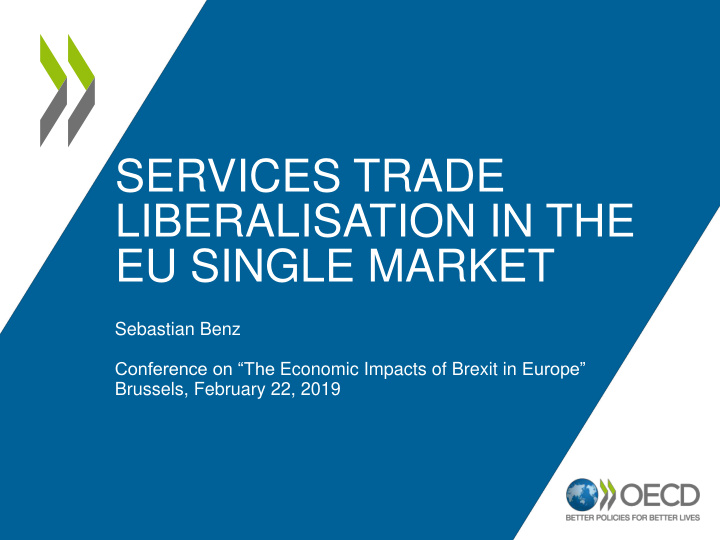



SERVICES TRADE LIBERALISATION IN THE EU SINGLE MARKET Sebastian Benz Conference on “The Economic Impacts of Brexit in Europe” Brussels, February 22, 2019
High economic importance of services Employment in services Services exports in bio. USD 6000 600 90 80 5000 500 70 4000 400 60 50 3000 300 40 2000 200 30 20 1000 100 10 0 0 0 1991 1996 2001 2006 2011 2016 1991 1996 2001 2006 2011 2016 World (left scale) OECD members (left scale) World OECD members United Kingdom United Kingdom (right scale) 2
High economic importance of services Services exports in bio. USD United Kingdom 2016: 6000 600 • Services exports: 330 bio. USD (cross-border only) 5000 500 Goods exports: 400 bio. USD • 4000 400 • 34% services value added in manufacturing exports 3000 300 • Mode 3 services exports: 670 bio. USD 2000 200 1000 100 0 0 1991 1996 2001 2006 2011 2016 World (left scale) OECD members (left scale) United Kingdom (right scale) 3
OECD Services Trade Restrictiveness Index (STRI) • Database of services trade restrictions • 45 economies, 22 sectors, 5 years: – 36 OECD Members, Colombia, Costa Rica, Brazil, China (PRC), India, Indonesia, Malaysia, South Africa, Russia • Standardised set of measures: between 61 (computer services) and 143 (insurance) per sector: 8 8000 observations per year • Five policy areas: 1. Restrictions on foreign entry 2. Restrictions to the movement of people 3. Other discriminatory measures 4. Barriers to competition 5. Regulatory transparency 4
STRI sectoral coverage Trade and Digital Physical Supply Chain Finance Network Infrastructure Support Computer Transport Legal Architecture Telecoms Logistics Accounting Engineering Audiovisual Distribution Financial Construction 5
STRI is a composite index • Takes values between 0 (open) and 1 (closed) • Codified algorithm applied to the information in the regulatory database – Binary scores – Break complex or continuous measures into several thresholds – Nested layers/hierarchies of measures – Regulatory packages when measures are complementary – Memos: included in database but no score attached • STRI annual updates: Monitoring trade policy and providing annual data for research and analysis 6
STRI methodology • Traditionally: data collected on most favored nation (MFN) basis – Rules applying to WTO members – No information on bilateral trade restrictiveness • January 2019: new intra-EEA STRI – Services trade barriers within EU Single Market – Coverage of EU law and national legislation – Different levels of restrictiveness across EEA member countries 7
Importance of EU legislation EU measures National measures 1 0.9 0.8 0.7 0.6 0.5 0.4 0.3 0.2 0.1 0 8
Intra-EEA STRI sector profiles 2018 Minimum Maximum Average EEA MFN Average 0.5 0.5 0.45 0.45 0.4 0.4 0.35 0.35 0.3 0.3 0.25 0.25 0.2 0.2 0.15 0.15 0.1 0.1 0.05 0.05 0 0 9
Air transport 0.5 0.4 0.3 0.2 0.1 0 Third Countries Single Market Restrictions on foreign entry Restrictions to the movement of people Other discriminatory measures Barriers to competition Regulatory transparency 10
Legal services 0.5 0.4 0.3 0.2 0.1 0 Third Countries Single Market Restrictions on foreign entry Restrictions to the movement of people Other discriminatory measures Barriers to competition Regulatory transparency 11
Commercial banking 0.5 0.4 0.3 0.2 0.1 0 Third Countries Single Market Restrictions on foreign entry Restrictions to the movement of people Other discriminatory measures Barriers to competition Regulatory transparency 12
Road freight transport 0.5 0.4 0.3 0.2 0.1 0 Third Countries Single Market Restrictions on foreign entry Restrictions to the movement of people Other discriminatory measures Barriers to competition Regulatory transparency 13
Findings • Single Market achievements: – Internal restrictions vs. third country restrictions: differ by a factor of four on average – Largest absolute difference in legal services, air transport and accounting; smallest in distribution • BUT: Services trade barriers remain in all sectors • Regulatory harmonisation within Single Market: – Regulatory heterogeneity drops by factor of four. – Harmonisation most advanced in road freight transport and air transport 14
Contact us We look forward to hearing from you! Access all of the You can reach us via We invite you to connect with information from the e-mail by sending your us on Twitter by following: message to the following Trade & Agriculture address: Directorate at: www.oecd.org/tad tad.contact@oecd.org @OECDtrade 15
Recommend
More recommend